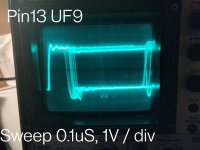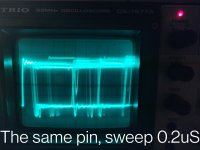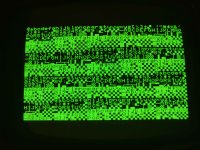Uh,
Uh, Ok...
I decided this morning to test E7 and E8 being as they shared a data bus with the VRAM.
I fired up the PET expecting the garbled mess of "shimmering" characters that it started doing recently.
Nope. The display has reverted to
exactly how it was when I very first started working on this pet.
Greetings all,
I'm new here, but thought this might be the right place to ask for any kind advice in fixing a PET I acquired recently. I've attached several images of what occurs on boot having cleaned the board and sockets to hell and back.
I suspected initially that the issue was VRAM, so I swapped the original MOS MPS 2114s for two NEC UPD2114LO-2s that I've used with no issues in several C64s. As attached, the weird garbled mess on the screen is different, and swapping the new VRAMs around seems to change which characters are in what position; otherwise (without swapping positions), they are the same on every boot.
There's no familiar beep / chime when switched on, and having removed the 6502 seems to have absolutely no effect on what's displayed.
I've also checked the voltages on each power line and they correspond to the diagrams, give or take ~10%. The traces all seem visually spotless too.
Don't suppose anyone has any advice on what could be at fault, or what to check (and how, I am a little dim).
Thanks again!
^ If you notice the "after VRAM swap" image of the original post, it matches identically the display currently.
Is the PETTEST EPROM dead?
I did test some capacitors that looked slightly larger than others with a multimeter (all just about within +-10%), if that killed my EPROM I resign!
I also blew the dust off of my board in case a hair or somesuch had fallen on the board (noticed that before testing so to be safe I cleaned it).
The current display of the PET:

EDIT:
I was just about to post this, but tested it again one more time. It did the shimmering thing and displayed some slightly different characters.
Restarted it. No more shimmering. The inverted luminance colours are now more correct:
EDIT 2:
Trying to get a photo of that, it's back to how it was at the start of this message. What the deuce is this thing doing...?
I'd thought it might be a capacitor problem because I left the machine a little while to write out this message. I did so again and no, back to the start of the message (image above)
I am... lost for ideas now.




